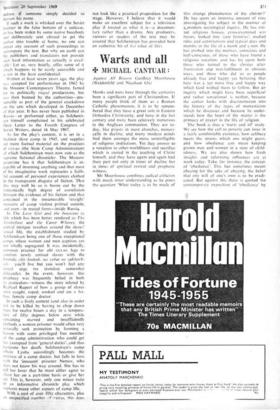Warts and all ÷ MICHAEL CANTUAR
Against All Reason Geoffrey Moorhouse (Weidenfeld and Nicolson 63s)
Monks and nuns have through the centuries been a significant part of Christendom. If many people think of them as a Roman Catholic phenomenon, it is to be remem- bered that they have a great role in Eastern Orthodox Christianity, and have in the last century and more been relatively numerous in the Anglican communion. They are to- day, like priests in most churches, numeri- cally in decline; and many modern minds find them amongst the more unintelligible of religious institutions. Yet they answer to a vocation to other-worldliness and sacrifice which is rooted in the teaching of Christ himself, and they have again and again had their part not only in times of decline but in times of spiritual revival and prophetic witness.
Mr Moorhouse combines radical criticism with much inner understanding as he poses the question 'What today is to be made of
this strange phenomenon of the cloister?' He has spent an immense amount of time investigating his subject in the manner of k,modern sociological inquiry. He has visi- ted religious houses, cross-examined wit-- nesses, looked into 'case histories', studied rules and constitutions and typical days and months in the life of a monk and a nun. He has probed into the motives, conscious and half-conscious, of those who have found a religious vocation, and has hit upon both those who turned to the cloister after frustration and non-fulfilment in obvious ways. and those who did so as people already free and happy yet believing that here was a yet more free and happy way which God wished them to follow. But an inquiry which might have been superficial and rather sensational is neither, because the author looks with discrimination into the history of the types of monasticism which he discusses and because he under- stands how the heart of the matter is the primacy of prayer in the life of religion.
The book is thus a 'warts and all' study. We see how the call to poverty can issue in a fairly comfortable existence, how celibacy meets the strains which one might guess, afid how obedience can mean keeping grown men and women in a state of child- ishness. We are also shown how fresh insights and reforming influences are at work today. Take, for instance, the concept of 'obedience'. This has sometimes meant obeying for the sake of obeying, the belief that any will of one's own is to be eradi- cated. But against this there is quoted the contemporary exposition of 'obedience' by Cardinal Suenens, who sees it in a very different light as the perception of the good- ness of the will of Christ, and the free res- ponse to it as being for the good of a community.
Quo tendimus? The book suggests that if monasticism survives it will be by finding a 'new look' somewhat nearer to the life of the modern world. But the title itself shows the author's awareness that, for all the need of a 'new look', the heart of the matter is that many Christians have been called and are ready still to be called to what the world is likely to deem utter folly. So it was with Christ and the apostles.









































 Previous page
Previous page